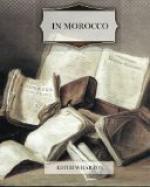Half terrified but wholly interested, these infants buzzed about the motor while we stopped to photograph them; and as we watched their antics we wondered whether they were the descendants of the little Soudanese boys whom the founder of Meknez, the terrible Sultan Moulay-Ismael, used to carry off from beyond the Atlas and bring up in his military camps to form the nucleus of the Black Guard which defended his frontiers. We were on the line of travel between Meknez and the sea, and it seemed not unlikely that these nourwals were all that remained of scattered outposts of Moulay-Ismael’s legionaries.
After a time we left oueds and villages behind us and were in the mountains of the Rarb, toiling across a high sandy plateau. Far off a fringe of vegetation showed promise of shade and water, and at last, against a pale mass of olive-trees, we saw the sight which, at whatever end of the world one comes upon it, wakes the same sense of awe: the ruin of a Roman city.
Volubilis (called by the Arabs the Castle of the Pharaohs) is the only considerable Roman colony so far discovered in Morocco. It stands on the extreme ledge of a high plateau backed by the mountains of the Zerhoun. Below the plateau, the land drops down precipitately to a narrow river-valley green with orchards and gardens, and in the neck of the valley, where the hills meet again, the conical white town of Moulay Idriss, the Sacred City of Morocco, rises sharply against a wooded background.
So the two dominations look at each other across the valley: one, the lifeless Roman ruin, representing a system, an order, a social conception that still run through all our modern ways, the other, the untouched Moslem city, more dead and sucked back into an unintelligible past than any broken architrave of Greece or Rome.
Volubilis seems to have had the extent and wealth of a great military outpost, such as Timgad in Algeria; but in the seventeenth century it was very nearly destroyed by Moulay-Ismael, the Sultan of the Black Guard, who carried off its monuments piece-meal to build his new capital of Meknez, that Mequinez of contemporary travellers which was held to be one of the wonders of the age.
Little remains to Volubilis in the way of important monuments: only the fragments of a basilica, part of an arch of triumph erected in honour of Caracalla, and the fallen columns and architraves which strew the path of Rome across the world. But its site is magnificent; and as the excavation of the ruins was interrupted by the war it is possible that subsequent search may bring forth other treasures comparable to the beautiful bronze sloughi (the African hound) which is now its principal possession.
It was delicious, after seven hours of travel under the African sun, to sit on the shady terrace where the Curator of Volubilis, M. Louis Chatelain, welcomes his visitors. The French Fine Arts have built a charming house with gardens and pergolas for the custodian of the ruins, and have found in M. Chatelain an archaeologist so absorbed in his task that, as soon as conditions permit, every inch of soil in the circumference of the city will be made to yield up whatever secrets it hides.




